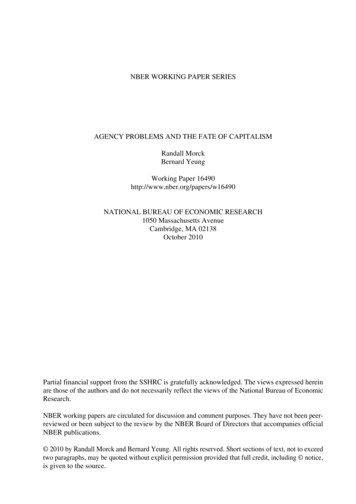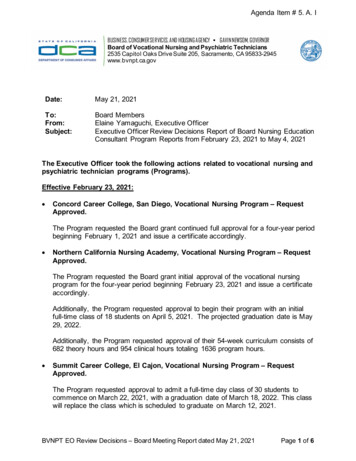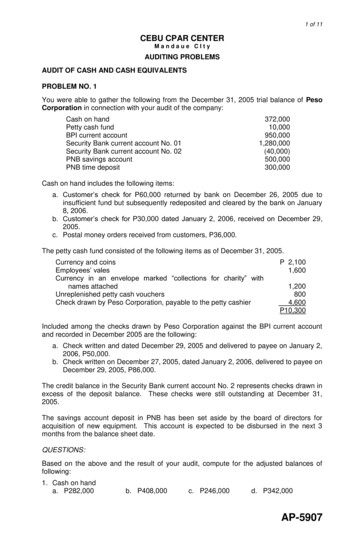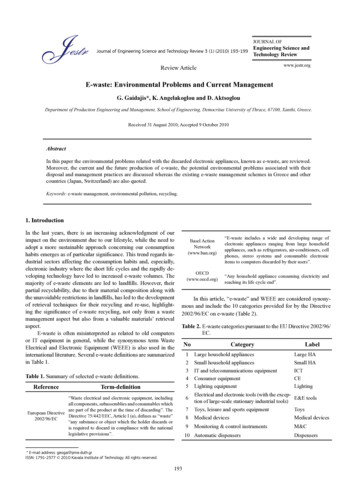
Transcription
NBER WORKING PAPER SERIESAGENCY PROBLEMS AND THE FATE OF CAPITALISMRandall MorckBernard YeungWorking Paper 16490http://www.nber.org/papers/w16490NATIONAL BUREAU OF ECONOMIC RESEARCH1050 Massachusetts AvenueCambridge, MA 02138October 2010Partial financial support from the SSHRC is gratefully acknowledged. The views expressed hereinare those of the authors and do not necessarily reflect the views of the National Bureau of EconomicResearch.NBER working papers are circulated for discussion and comment purposes. They have not been peerreviewed or been subject to the review by the NBER Board of Directors that accompanies officialNBER publications. 2010 by Randall Morck and Bernard Yeung. All rights reserved. Short sections of text, not to exceedtwo paragraphs, may be quoted without explicit permission provided that full credit, including notice,is given to the source.
Agency Problems and the Fate of CapitalismRandall Morck and Bernard YeungNBER Working Paper No. 16490October 2010JEL No. B53,G28,G34,N20,P1,P12ABSTRACTEconomics has firms maximizing value and people maximizing utility, but firms are run by people.Agency theory concerns the mitigation of this internal contradiction in capitalism. Firms need charters,regulations and laws to restrain those entrusted with their governance, just as economies need constitutionsand independent judiciaries to restrain those entrusted with government. Agency problems distortcapital allocation if corporate insiders are inefficiently selected or incentivized, and this hampers economicgrowth absent a legal system with appropriate constraints. However, political economy problems andagency problems in corporations may reinforce each other, compromising the quality of both corporategovernance and government.Randall MorckFaculty of BusinessUniversity of AlbertaEdmonton, CANADA T6G 2R6and NBERrandall.morck@ualberta.caBernard YeungNational University of SingaporeMochtar Riady Building15 Kent Ridge DriveBIZ 1, Level 6, #6-19Singapore 119245bizdean@nus.edu.sg
1.IntroductionNeoclassical economics presents “capitalism” as a system where multitudes of firms compete to offercustomers the best prices. To many, especially outside America and Britain, “capitalism” is a systemwhere a handful of old‐monies families run the economy – often badly. The economists marvel at theothers’ credulity for conspiracy theories, while the others marvel at economists’ naivety about the “realworld”. Close inspection of corporate governance in different countries suggests that each side well takethe other seriously. Capitalism has genuinely different forms in different countries, and these reflectfundamental differences in the distributions of corporate and political control.Neoclassical economics readily allows that who controls a country’s government matters, buttraditionally takes firms as profit maximizing black boxes and capital as a return‐generating substancethat Samuelson dubbed shmoo. Yet who controls firms, and their capital, matters (Berle and Means1932). How microeconomics can incorporate this insight is the core issue of agency theory (Jensen andMeckling 1976).Running a business requires scarce talent, and competition among potential leaders ideallyassigns corporate control to the most able. Adam Smith (1762) posits that business success requires anempathic ability to predict potential customers’ desires. Hayek (1941, c. 25, p. 335) stresses theimportance of exceptional foresight; Knight (1921 c. 9 §3.9.7) stresses the rarity of rational decision‐making ability; and Schumpeter (1912) sees uniquely creative innovators building new corporations thatdestroy old ones, and thereby earning the wrath of all who preferred the status quo.Somewhat more cynically, and more in line with the recent corporate governance literature,Adam Smith (1776, bk. 5, c. 1, pt. 3, art. 1) holds that corporate directors “seldom pretend tounderstand anything of the business of the company.” Keynes (1936, c. 12, §5) concurs with Smith,Hayek, Knight, and Schumpeter that “the social purpose of skilled investment is to defeat the dark forcesof time and ignorance which envelop our future”, he despairs that this is beyond the ability of corporateexecutives, whose decisions the attributes to behavioral “animal spirits” (c. 12, §7). Mueller (1992) thusadvocates a broadly behavioral approach to modeling managerial decision‐making. Brandeis (1914)blasts the ethics of corporate tycoons running firms built with “other people’s money”, and Berle andMeans (1932) describe a fundamental misalignment of their incentives.Corporate governance, broadly defined, continues this discussion. Capital is not schmoo, forwho controls businesses matters, as do the institutions that determine this, the interest groups thataffect these institutions, and thus the interface between financial economics and political economy.1
While economic theory addresses all these issues, incentive misalignment attracts the mostattention – perhaps because it highlights an internal contradiction within that theory. Neoclassicaleconomics posits that individuals maximize utility and that firms maximize economic profits or, moreprecisely, the expected present values (NPVs) of their capital investments – which, in turn, preciselyequal the expected present values of economic profits. This presents problems because, as Gabrowskiand Mueller (1972) rightly note, firms are run by people. Which then is paramount: a CEO’s utility orher firm’s NPV?Jensen and Meckling (1976), expanding earlier theories (Ross 1973) and reflecting previousempirical work rejecting pure value maximization (Baumol 1959; Grabowski & Mueller 1972 and others),provide the now standard resolution to this inconsistency. They assume utility maximization morefundamental, and their firms therefore do not maximize NPVs. The implicit sacrificed value they dub anagency cost. Specifically, they model outside investors – the firm’s owners or principals, as inCorporations Law – buying shares in firms run by utility maximizing insiders, whom Corporations Lawdeclares to be their agents. Elaborating what is now standard terminology, they christen this divergenceof interests a principal‐agent problem, now often abbreviated to agency problem. Corporate governanceis the study of agency problems and the monitoring and control mechanisms that limit agency costs.Neoclassical economics posits that price competition culls firms that do not maximize NPVs, andthus holds that agency problems ought to be brief and economically negligible (Demsetz & Villalonga2001). However, the empirical literature increasingly confirms non‐value‐maximizing decisions to becommonplace in corporate boardrooms, and far too economically important to be abstracted away (e.g.Shleifer & Vishny 1997; Gompers et al. 2003; Bebchuk & Fried 2004; Bebchuk et al. 2009).If firms do not maximize value, managerial utility maximization might cause firms to effectivelymaximize something else. Baumol (1959) posits sales maximization; and Baumol (1967) argues thatgrowth maximization best fits the facts – at least in the United States. Recent work in behavioral financesuggests alternative objective functions for individuals (Shleifer 2000), and Mueller (1992) argues thatsuch considerations be incorporated into models of managerial behavior. Early work along these linesincludes Stein (1989) and Scharfstein and Stein (1990), and Baker et al. (2004) review the area. Morck(2008) argues that a “loyalty reflex” demonstrated in Milgram’s (1974) experiments might compromiserdirectors’ judgment, and draws from variants of those experiments and the broader social psychologyliterature to evaluate governance reforms.Nonetheless, most work in the area presumes utilitymaximization by managers. This is perhaps justifiable, in that the critical issue is that neoclassicaleconomics assigns people, including managers, and firms different objective functions.2
Thus, Grabowski and Mueller (1972), Jensen (1986), and others argue that top executives attainhigher utility from running larger firms, and thus invest in negative PV projects merely to grow theirfirms. Jensen calls this sort of capital misallocation a free cash flow agency problem, defining free cashflow as the firm’s cash flow (revenues minus operating costs) less the setup costs of all its positive NPVinvestments. A value maximizing firm should pay its free cash flow out to its shareholders, rather thaninvest it in negative NPV projects, but Jensen presents evidence that free cash flow agency problems area first order determinant of overall agency costs. If this thesis is right, and the data suggest it is,microeconomic theory missed something very fundamental before the advent of agency theory.Fortunately, this gap can be spanned with deeper economics (Jensen and Meckling 1976). Moraloutrage about corporate misgovernance, in contrast, may be largely misdirected. Agency costs are oftendescribed as shareholder wealth expropriation. This is incorrect in an efficient market, whereshareholders buy low because they rationally foresee extensive agency problems, costly monitoring andcontrol mechanisms to limit agency problems, or a mixture of the two. Firms’ founders thus absorb allagency costs by selling their shares at depressed initial public offering (IPO) prices; and the shares tradeat fair value thereafter. Only outside shareholders who underestimate agency problems overpay andlose money on average, and this is expropriation unless caveat emptor applies.The real social costs of agency problems lie deeper in inner workings of the economy. Inefficientresource allocation by firms costs money, as do the monitoring and control mechanisms that might limitthose problems. Some level of agency costs is thus unavoidable. But both firms and economies can seekways to reduce unavoidable agency costs.All else equal, if corporate insiders more credibly pre‐commit to maximize NPVs, investors paymore for shares. Higher share prices make outside capital readily available to firms that need it,permitting growth in firms with genuine business opportunities (Mueller 2006a). But less trustingoutside investors and low share prices make outside capital scarce, growth is restricted to firms withabundant earnings from existing operations (La Porta & et al. 1997) – and these need not be the firmswith the most farsighted, rational, or innovative leadership. Governments can curtail agency costs withinstitutions that better facilitate or require such commitments by corporate insiders. All else equal,success at this cuts costs of capital to entrants and incumbents alike; promoting competition,innovation, and efficient resource allocation. Corporate governance is therefore most fundamentallyabout how honest and able corporate insiders can most efficiently and credibly commit to limit agencycosts, and about how governments can lower their costs of doing so (Shleifer and Vishny 1997; Bebchukand Weisbach 2010).3
Finally, a Handbook of Capitalism survey of corporate governance must pay due honor to Marx.The internal contradiction at the heart of corporate governance is not unrelated to Marx’s more famouscontention that competition drives surplus value to zero, and that this dooms capitalism. Schumpeter(1942, p. 31) interprets surplus value as the present value of abnormal returns to capital, essentially theNPVs of finance textbooks; and argues correctly that competition indeed drives these to zero. This stilldisturbs the equanimity of an occasional MBA student, who learns in microeconomics how economicprofits fall to zero under perfect competition, and then learns in Corporate Finance of the need for“positive NPV” projects – that is, investments with positive economic profits. A well‐placed between‐term or summer break obscures this discrepancy from all but the most insightful students; but its trueresolution, due to Schumpeter (1912), is that investment in innovation can have positive economicprofits for a time (Cable & Mueller 2008); and that successful innovators are exceptionally foresightedand coldly rational rarities. Corporate governance is thus most fundamentally about how to entrust thegovernance of businesses to people who are both able and willing to find the positive NPV projects thatSchumpeter evokes to save capitalism from Marxist doom. Good corporate governance is thereforefundame3ntally about piloting firms through disequilibrium situations, where economic profits can bevery large, and positive or negative.Ultimately, a free market economy creates social welfare by organizing the efficient division oflabor (Smith 1776). Increased efficiency in corporate governance thus places corporations more reliablyunder the control of top executives with specialized skills, talents, or information necessary for leadingtheir firm, organizing is core activities, developing its future capabilities, and mobilizing capital tofinancing its growth opportunism. But designing institutions that better align CEOs’ personal utilitymaximization with value maximization also promises improved microeconomic efficiency.Thenormative goal of economic analysis in this context is trustworthy and well‐qualified top corporatemanagers running firms that raise capital from rationally trusting investors. The positive goal ofeconomic analysis in this area is enlightenment as to how top corporate insiders, firms, and investorsactually behave, and the economic consequences of this.2.AGENCY PROBLEMS AND THE WEALTH OF NATIONSThe social purpose of the financial system is to entrust people’s savings to firms governed bytrustworthy people. Schumpeter’s famous circular flow fails if savers do not trust financial institutionsor financial markets, and instead bury coins in their gardens. But if savers can invest in bank accounts,bonds, and stocks knowing their money will be entrusted to genuine entrepreneurs who can capture4
genuine economic profits, the economy can mobilize its capital to finance huge firm capturing vasteconomies of scale, daring technological innovators, and perceptive entrepreneurs who perceivepreviously unexploited profit opportunities (Mueller 2006a).2.1BIG BUSINESS, TRUST, AND RICHESRosenberg and Birdzel (1986) argue that the joint stock company and other similar businessorganizational forms that let anonymous investors assemble huge pools of capital, and the institutionalarrangements necessary to them, are fundamental to “how the West grew rich” and surpassedpreviously more advanced civilizations such as the Arab World, China, and India. The West developedinstitutions that let entrepreneurs assemble vast pools of capital from diverse investors, while the restdid not.For large publicly traded companies to be viable, savers must trust corporate insiders to governefficiently. Insiders can make commitments to do so at the firm level by granting shareholders votingrights, nominating trustworthy directors, mandating independent board committees, voluntarilydisclosing important information, adopting managerial incentive pay schemes, and the like. However,Rosenberg and Birdzel stress how country‐level institutional developments are more important to thecredibility of such commitments. Promises to honor shareholders appear incredible without predictablelaws and regulations governing financial markets, efficient and dispassionate courts, honest civilservants, mandatory disclosure rules, responsible government, and the like.With the discovery of sea routes to around Africa to Asia and of the New World, the spice, fur,tobacco, and slave trades promised high returns but required vast capital outlays beyond the capabilitiesof even the wealthiest merchants and aristocrats. The solution to this quandary, the joint stockcompany, was 17th century Dutch invention.1Before the invention of the joint stock company, maritime trade was organized one ship at atime. At the end of each voyage, the ship and cargo were sold and the proceeds divided between thecaptain and crew, the provisioners, and the financiers with each party’s dividend (in the arithmeticsense) pre‐specified in the contract. Financiers diversified the risk of loss at sea by buying shares inmultiple voyages, rather than backing a single ship. Over time, these arrangements expanded to includeseveral ships or all voyages for a fixed number of years.1Subsequent paragraphs draw from Frentrop (2002).5
The modern world’s first joint stock company, the Dutch East India Company or VereenigdeOost‐Indische Compagnie (VOC) was formed in 1602.2 It was, according to the prominent investor Isaacle Maire (1558‐1624), governed in a way “entirely absurd and impertinent” to the “displeasure andcomplaint of both the people in the street and the investors”.3 This displeasure arose because, to leMaire’s fury, the VOC directors refused to dissolve the venture, and instead used each voyages’ profitsto finance the next, paying dividends from the residual only. Moreover, they appeared intent oncontinuing this “absurd” practice indefinitely! Le Maire wanted his money out of the VOC because hefelt its directors were running the company too laxly.They were building fine houses alongAmsterdam’s best canals, but letting others grab promising business opportunities in Asia.On January 24 1609, in what (to our knowledge) is the first recorded corporate governancedispute, le Maire formally charged that the directors sought to “retain another’s money for longer oruse it ways other than the latter wishes” and petitioned for the liquidation of the VOC in accordancewith standard business practice. The petition was denied, and investors who wanted out were forced tofind another exit strategy. The only option left to them was selling the shares of the VOC they owned toother investors, for some merchants who had not participated in the initial voyage were indeedinterested in earning dividends from a second round of voyages.Because le Maire lost, a new business model arose – the publicly traded, indefinitely long‐lived,joint stock corporation with publicly traded shares. This innovation financed the successive waves ofindustrial revolution that created the modern world. But le Maire was also quite likely correct in arguingthat the directors of the VOC were growing fat and indolent, living off the shareholders’ hard‐earnedmoney. Today’s top managers have moved on, graduating from fine canal houses to Lear Jets, andshareholders object just as vociferously. And today’s top corporate managers, just as confidently,assure shareholders it’s all actually in their best interests.Ultimately, Dutch shareholders accepted the new model, and British organizers copied it,especially after the Glorious Revolution of 1688 brought Dutch courtiers and ideas to London. Vast poolsof capital soon funded huge joint stock companies, like the British East India Company and the Hudson’sBay Company which, at their apogees, owned sizable fractions of India and Canada, respectively. Othersorganized settler colonies, slaving expeditions, and slave plantations. The model soon spread to Franceand across Europe.2Lit. United East Indian Company. The VOC had antecedents in Flanders, and probably elsewhere; and businessessimilar to joint stock companies likely existed in Roman times (Malmendier 2005).3(Frentrop 2002, c. 2) superbly documents the early corporate governance disputes of the VOC, and is our sourcefor the following historical case studies.6
Questionable business models, especially slaving and slave plantations, and later the opiumtrade in China, attracted opprobrium to joint stock companies. But so did a popular perception oframpant mismanagement. Writing more than half a century after Smith (1776, bk. 5, c1, pt. 3, art. 1)despairs that “The directors of such companies . being the managers rather of other people's moneythan of their own, it cannot well be expected that they should watch over it with the same anxiousvigilance with which the partners in a private copartnery
resolution, due to Schumpeter (1912), is that investment in innovation can have positive economic profits for a time (Cable & Mueller 2008); and that successful innovators are exceptionally foresighted and coldly rational rarities. Corporate gover











